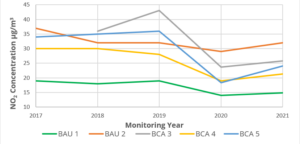Being the second-largest city in the UK after London, Birmingham has unsurprisingly faced challenges with poor air quality for many years. Air pollution in Birmingham is largely generated by vehicle emissions, with many of Birmingham’s major roads being known to have high levels of atmospheric pollutant build up. The primary pollutants of concern are nitrogen dioxide (NO2) and particulate matter (comprising of PM10 and PM2.5), with the elevated concentrations of these pollutants being strongly correlated to areas with high traffic volumes.
The severity of Birmingham’s air pollution levels changed considerably over the last several years, with pollutant concentrations generally trending downwards at a gradual rate, but the impact of COVID-19 has also played a major role in recent years. A significant (but transient) drop in pollutant concentrations was seen nationwide during 2020 due to the impacts of travel restrictions in response to the COVID-19 pandemic. These gradually rose back up in the following years.
This effect of COVID-19 on air quality is exemplified through the air quality monitoring undertaken by Birmingham City Council (BCC), the results of which are published in the Air Quality Annual Status Report on a yearly basis. The figure below presents the monitored average annual concentration of NO2 at five automatic (continuous) air quality monitoring stations operated throughout Birmingham between the 2017 and 2021.

As shown in the above figure, NO2 concentrations at the majority of these five monitoring stations fell considerably during 2020, with some locations showing concentrations almost half as low as the 2019 average. This is a result of decreased volumes of road traffic due to the travel restriction associated with the COVID-19 pandemic. This demonstrates how pollution generated from road traffic is a major contributing to Birmingham’s generally poor air quality.
It should be noted that at several of the monitoring stations, NO2 concentrations do not rise back up to pre-2020 levels. This may be due in part to road traffic volumes still somewhat reduced during 2021 but may also be attributable to the introduction of Birmingham’s ‘Clean Air Zone’, which we discuss below.
Air quality in Birmingham has also been affected in recent years by the introduction of the Clean Air Zone (CAZ) in the centre of the city, which came into effect in June 2021. The scheme has meant that vehicles which do not meet the emission standards or have an exemption are now subject to a daily charge if they enter the zone, in an attempt to improve air quality by reducing the volume of the most polluting vehicles within the city centre. BCC reported that following the introduction of the CAZ, the volume of the most polluting vehicles entering the city centre fell by almost 19% in under a year, with this having been linked to an overall reduction in NO2 concentrations of 13% within the first six months of the scheme being introduced.
In order to maintain and encourage the general downward trend of pollutant concentrations throughout the city, BCC have committed to several pledges in tandem with Birmingham’s Air Quality Strategy, as detailed within their Air Quality Action Plan. These are:
- The introduction a Clean Air Zone in Birmingham City Centre;
- Continuing to deliver a world class transport system which prioritises public transport, cycling and walking;
- Identify schools which are exposed to air pollution problems and work with the school to identify intervention strategies to reduce the exposure of the children;
- Expand the air quality monitoring network, incorporating new technologies and through partnership working with educational institutions and citizen science projects we will make the results readily available to all;
- Further develop our approaches to tackling emissions from both existing buildings and proposed developments;
- Work with key partners and stakeholders throughout the West Midlands region to help inform our work and provide leadership where required.
The Curzon Street HS2 station, which is currently in development, is located just east of Birmingham’s city centre, in an area of relatively poor air quality. Being located in proximity to the A47, Lawley Middleway ring road and Birmingham Moor Street Station, the area has relatively high NO2 concentrations, with the closest monitoring location (diffusion tube BHM43) recording a value of 39.5 µg/m3, almost exceeding the national air quality objective for NO2.
Environmental consultancies like Temple play an important role in facilitating the continued improvement of air quality in Birmingham. This can include Temple providing bespoke air quality assessments for developments throughout the city, and providing expert advice on how emissions can be minimised. This often relates to helping developers control dust and particulate matter emissions from construction sites, by advising on the optimal equipment and strategies for specific sites, which is especially important for sites located in areas with already poor existing air quality, such as the Curzon Street site. This may also involve Temple undertaking continuous air quality monitoring at many construction sites, with the ability to identify exceedances in real-time, enabling Temple to inform developers so that site operators can take immediate action to mitigate emissions. Additionally, Temple provides professional training modules to help educate both the public and professionals in relevant industries on issues surrounding air quality.